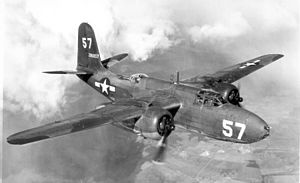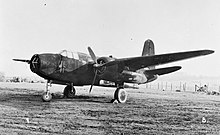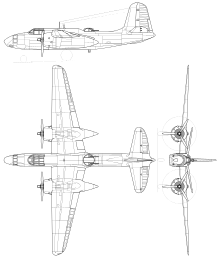Douglas A-20
| Douglas DB-7 / A-20 Havoc / Boston | |
|---|---|
 An A-20G "Havoc" of the US Army Air Forces |
|
| Type: | bomber |
| Design country: | |
| Manufacturer: | |
| First flight: |
January 23, 1938 |
| Commissioning: |
1941 |
| Production time: |
1940 to 1944 |
| Number of pieces: |
7478 |
The Douglas A-20 (factory designation DB-7 ) was a twin-engine fighter aircraft made by the US American manufacturer Douglas Aircraft Company during the Second World War .
It was mainly used as a light bomber by several Allied air forces and was called z. B. at the Royal Air Force Boston , the variants for night missions Havoc . The US Army Air Corps gave the bomber the designation A-20 Havoc , the night fighter developed from it received the designation P-70 Havoc.
history
Development began in 1937 and the prototype had its maiden flight on October 26, 1938. Despite meeting the specifications for a light twin-engine bomber, the US Army Air Corps did not appear to be interested in purchasing this aircraft.
The first customer was France in February 1939 with an order for 100 DB-7A machines ; after the outbreak of World War II, the order was supplemented by 170 more machines in October 1939. Even Belgium ordered a batch of 16 aircraft of this type. At the time of the German attack in the west , only about 70 machines had been delivered to the Armée de l'air and were used against the German troops. Some machines were lost in battle. The remainder fled to Britain or became part of the Vichy Air Force .
The majority of the French order, comprising 270 aircraft, was withheld in the USA or - including the Belgian order - went to the Royal Air Force, which urgently needed a light bomber / night fighter. There the machines were designated Boston Mk.I . Before its surrender, France ordered a large production order for 480 machines of the DB-73 version , which was essentially the approximately 15 cm longer and slightly improved variant DB-7B with French on-board instruments. These aircraft never made it to France for delivery and were instead delivered to the Royal Air Force after being converted. Great Britain later ordered 300 more DB-7Bs, which were called the Boston Mk.III there .
3414 machines were delivered to the USSR as part of the loan and lease agreement , 2771 of them to the Soviet air force . The USSR had more A-20s than the US Army Air Forces, which received almost 2,000 machines. The aircraft were delivered to the Soviet Union via the Alaska-Siberia route and the Persian Corridor . Used they came in June 1942. The Soviet forces were .30-Browning machine guns with the four because of their cadence not satisfied of 600 rounds per minute and exchanged them against 7.62 mm SchKAS triple rate of fire. In the summer of 1942, A-20s flew missions against anti-aircraft German convoys. Attempts were made to fly under the flak at low altitude down to 10 m. There were heavy losses. By mid-1943, the level of training of the Soviet pilots had risen and they appreciate the A-20B and A-20C because of their powerful engine and the resulting speed and maneuverability. They could fly tight turns of up to 65 ° and the tripod landing gear had proven itself. The requirements for pilot training were low. The engines proved to be reliable, except for weaknesses at low temperatures. Soviet engineers therefore developed covers to protect the propeller hubs from freezing. Some were equipped with fixed cannons and successfully used in ground combat.
A total of 7,478 A-20s were produced.
variants
- Boston i
- Pratt & Whitney R-1830 -S3C-G engines, acquisition of DB-7A, which France originally ordered, by the Royal Air Force, built around 20
- Boston ii
- R-1830-S3C4-G engines, also from the French order, 183 built
- Havoc I
- Conversion of 181 French DB-7s as well as Boston I and II to night fighters with AI Mk.IV or Mk.V radar
- Havoc I (LAM)
- Retrofitting of 20 Havoc I with a long aerial mine (LAM), which was supposed to be brought into the trajectory of opposing aircraft on a 610 m long cable. After unsuccessful demolition to Havoc I.
- Havoc I Turbinlite
- Equipment 31 Havoc I with 2700 million candela (2.7 Gcd) headlights in the aircraft nose to illuminate enemy aircraft for hurricane night fighters
- DB-7A / Havoc II
- Version with 1600 hp (1195 kW) Wright R-2600-A5B Double Cyclone engines originally ordered by France . 39 were converted to “Turbinlite” aircraft at short notice. 200 built
- DB-7B / Boston III
- The first version ordered by Great Britain as Douglas "DB-7B" with R-2600-A5B engines, improved armor and larger fuel supply, 568 built
- Boston IIIA
- Converted A-20C delivered to the UK under the Loan and Lease Act , 255 built
- DB-7C
- Version ordered by the Netherlands for use in the Dutch East Indies , which were delivered to the USSR after the conquest by Japan .
- A-20
- USAAF prototype with Wright R-2600-7 engines, 1 built, later converted to XP-70
- A-20A
- R-2600-3 engines, 143 built, 9 delivered to Australia in 1943, one to the United States Navy for testing purposes as BD-1
- A-20B
- R-2600-11 engines, 999 built, 665 of which were delivered to the USSR, eight as BD-2s to the US Navy as target tow planes
- A-20C
- R-2600-23 engines, self-sealing tanks, improved armor. The A-20C could carry a torpedo under the fuselage. Built in 948
- A-20D
- High altitude bomber, not built
- A-20E
- Equipping 17 A-20A with R-2600-11 engines as test aircraft
- XA-20F
- Equipping an A-20A with a 37 mm T-20-E-1 cannon in the aircraft nose, nicknamed "Porcupine" (porcupine)
- A-20G
- 1600 hp (1200 kW) R-2600-23 engines. The aircraft nose was not glazed, but closed and equipped with four modified Hispano-Suiza-HS.404 -20 mm cannons and two Browning M2 -MGs of caliber .50 BMG (12.7 mm). After 250 machines were built, the unreliable cannons were exchanged for machine guns. 2850 built
- A-20H
- 1700 hp (1270 kW) R-2600-29. 412 built
- A-20J / Boston IV
- A-20H with a glass nose. 450 built, 169 of which were delivered to the RAF
- A-20K / Boston V
- A-20J with R-2600-29 engines, 413 built
- P-70
- Conversion of the A-20 into a night fighter
- P-70A
- Night fighter conversion from A-20C, equipped with SCR-540 radar (licensed by the British AI Mk.IV)
- P-70B
- Night fighter conversion from A-20G and A-20J C, equipped with American SCR-720 or SCR-729 radar
- F-3A
- Conversion of 46 A-20J / K for night reconnaissance
production
Acceptance of the A-20 by the USAAF:
| Manufacturer | version | 1940 | 1941 | 1942 | 1943 | 1944 | TOTAL |
|---|---|---|---|---|---|---|---|
| Boeing, Seattle | A-20 | 195 | 185 | 380 | |||
| Douglas, Long Beach | A-20 | 1 | 975 | 23 | 999 | ||
| Douglas, Santa Monica | A-20 | 297 | 815 | 625 | 1.952 | 2,317 | 6.006 |
| Douglas, Santa Monica | P-70 | 60 | 60 | ||||
| Douglas, Santa Monica | F-3 | 3 | 3 | ||||
| TOTAL | 297 | 815 | 1,848 | 1,975 | 2,317 | 7,448 |
Technical data DB-7B
- Span: 18.70 m
- Wing area: 43.1 m²
- Length: 14.4 m
- Height: 5.5 m
- Drive: Two 14-cylinder double radial engines Pratt & Whitney R-1830 S3C3-G Twin Wasp with approx. 1100 HP
- Maximum speed: 490 km / h
- Cruising speed: 297 km / h
- Range: approx. 2500 km (without bombs)
- Summit height: approx. 8000 m
- Armament
- Up to 907 kg bomb load
- Six 7.62 mm machine guns in the fixed nose and two movable 12.7 mm machine guns on the fuselage (low attack version)
- Four 7.62 mm machine guns on the side of the glass nose, two movable 7.62 mm machine guns on the fuselage (bomber version)
Technical data A-20G
- Span: 18.69 m
- Wing area: 43.11 m²
- Length: 14.63 m
- Height: 5.36 m
- Drive: Two double radial engines Wright R-2600-23 Double Cyclon with 1622 HP each
- Maximum speed: 546 km / h at 3780 m
- Cruising speed: 410 km / h
- Range: 1754 km with normal bomb load
- Summit height: 7865 m
- Armament
- Up to 1814 kg bomb load
- Six 12.7 mm machine guns in the fixed nose, two movable 12.7 mm machine guns on the back of the fuselage and one 12.7 mm machine gun in the lower armament
See also
Web links
Individual evidence
- ^ Jefim Gordon : Soviet Air Power in World War 2 . Midland, Hinkley 2008, ISBN 978-1-85780-304-4 , pp. 453 .
- ^ "Douglas A-20 Havoc / Boston." Militaryfactory.com. accessed on July 28, 2017.
- ↑ Statistical Digest of the USAF 1946, p. 100 ff.



